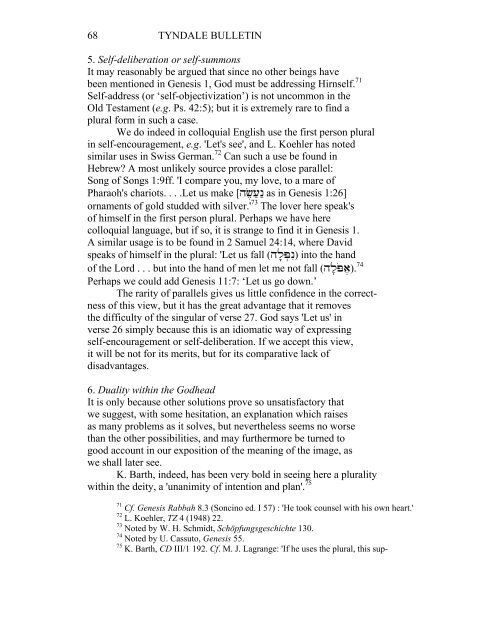THE IMAGE OF GOD IN MAN - Tyndale House
THE IMAGE OF GOD IN MAN - Tyndale House
THE IMAGE OF GOD IN MAN - Tyndale House
- TAGS
- tyndale
- tyndalehouse.com
You also want an ePaper? Increase the reach of your titles
YUMPU automatically turns print PDFs into web optimized ePapers that Google loves.
68 TYNDALE BULLET<strong>IN</strong><br />
5. Self-deliberation or self-summons<br />
It may reasonably be argued that since no other beings have<br />
been mentioned in Genesis 1, God must be addressing Hirnself. 71<br />
Self-address (or ‘self-objectivization’) is not uncommon in the<br />
Old Testament (e.g. Ps. 42:5); but it is extremely rare to find a<br />
plural form in such a case.<br />
We do indeed in colloquial English use the first person plural<br />
in self-encouragement, e.g. 'Let's see', and L. Koehler has noted<br />
similar uses in Swiss German. 72 Can such a use be found in<br />
Hebrew? A most unlikely source provides a close parallel:<br />
Song of Songs 1:9ff. 'I compare you, my love, to a mare of<br />
Pharaoh's chariots. . . .Let us make [הֶ ׂשַעַנ as in Genesis 1:26]<br />
ornaments of gold studded with silver.' 73 The lover here speak's<br />
of himself in the first person plural. Perhaps we have here<br />
colloquial language, but if so, it is strange to find it in Genesis 1.<br />
A similar usage is to be found in 2 Samuel 24:14, where David<br />
speaks of himself in the plural: 'Let us fall (הָלְּפִנ) into the hand<br />
of the Lord . . . but into the hand of men let me not fall (הָלֹּפֶא). 74<br />
Perhaps we could add Genesis 11:7: ‘Let us go down.’<br />
The rarity of parallels gives us little confidence in the correctness<br />
of this view, but it has the great advantage that it removes<br />
the difficulty of the singular of verse 27. God says 'Let us' in<br />
verse 26 simply because this is an idiomatic way of expressing<br />
self-encouragement or self-deliberation. If we accept this view,<br />
it will be not for its merits, but for its comparative lack of<br />
disadvantages.<br />
6. Duality within the Godhead<br />
It is only because other solutions prove so unsatisfactory that<br />
we suggest, with some hesitation, an explanation which raises<br />
as many problems as it solves, but nevertheless seems no worse<br />
than the other possibilities, and may furthermore be turned to<br />
good account in our exposition of the meaning of the image, as<br />
we shall later see.<br />
K. Barth, indeed, has been very bold in seeing here a plurality<br />
within the deity, a 'unanimity of intention and plan'. 75<br />
71<br />
Cf. Genesis Rabbah 8.3 (Soncino ed. I 57) : 'He took counsel with his own heart.'<br />
72<br />
L. Koehler, TZ 4 (1948) 22.<br />
73<br />
Noted by W. H. Schmidt, Schöpfungsgeschichte 130.<br />
74<br />
Noted by U. Cassuto, Genesis 55.<br />
75<br />
K. Barth, CD III/1 192. Cf. M. J. Lagrange: 'If he uses the plural, this sup-

















